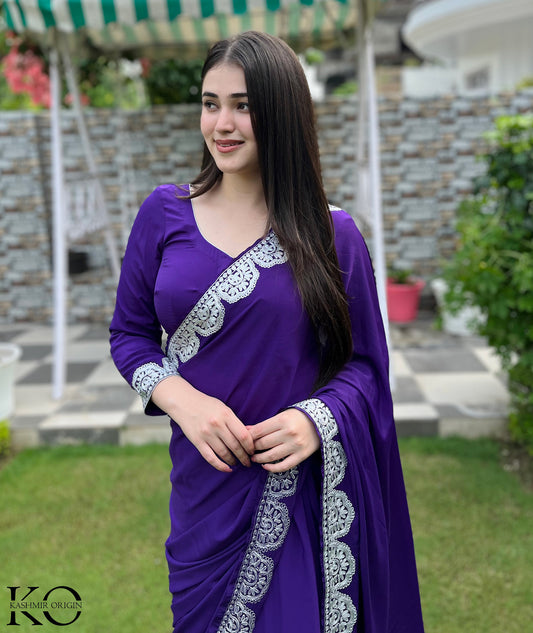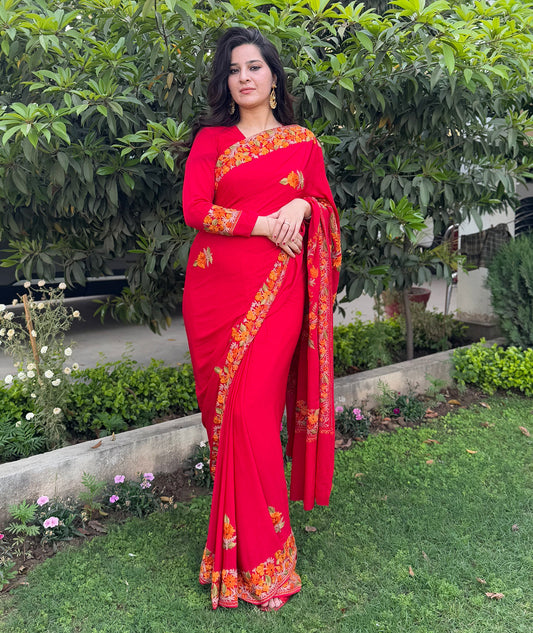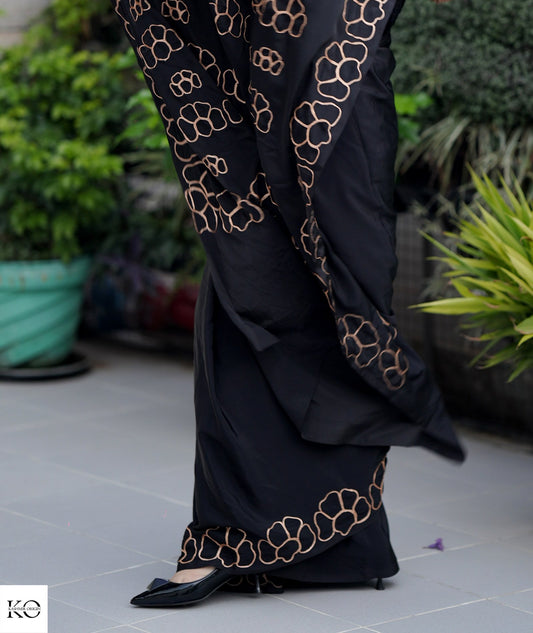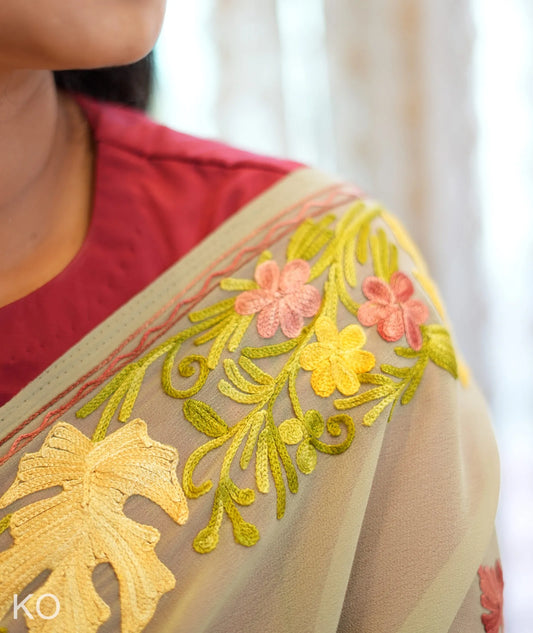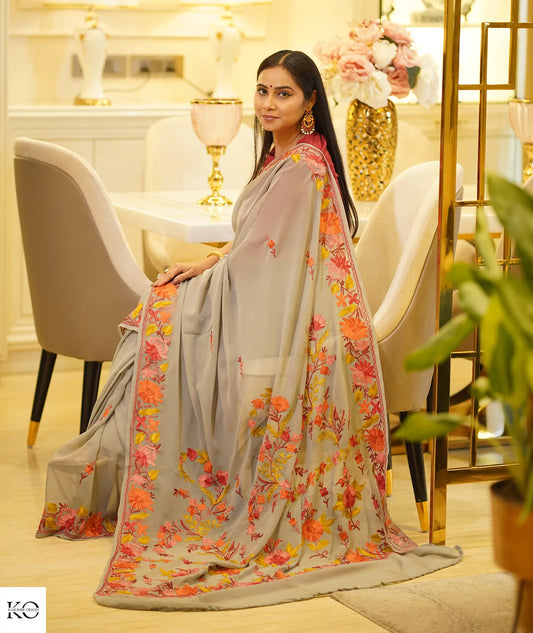Collection: Sarees
Kashmiri embroidered sarees are exquisite pieces of clothing known for their intricate craftsmanship and rich cultural heritage. The embroidery techniques used in Kashmiri sarees are centuries-old and reflect the region's artistic prowess.
Here are some key features of Kashmiri embroidered sarees:
1. **Types of Embroidery**: Kashmiri sarees often feature several types of embroidery, including Aari work, Sozni embroidery, and Tilla work. Aari work involves chain stitch embroidery using a hooked needle, Sozni embroidery is intricate needlework often done with silk threads, and Tilla work incorporates metallic threads for a touch of opulence.
2. **Designs and Patterns**: The designs on Kashmiri sarees are typically inspired by nature, with motifs like paisleys, flowers, birds, and chinar leaves being common. These motifs are intricately embroidered onto the saree, creating a stunning visual appeal.
3. **Fabric**: Kashmiri sarees are often made from luxurious fabrics such as Pashmina, silk, and georgette. Pashmina sarees, in particular, are highly prized for their softness, warmth, and fine texture.
4. **Color Palette**: Traditional Kashmiri sarees often feature a rich color palette including vibrant shades of red, blue, green, and gold. These colors are used to create striking contrasts and enhance the beauty of the embroidery.
5. **Occasions**: Kashmiri embroidered sarees are popular choices for special occasions such as weddings, festivals, and cultural events. They are considered elegant and timeless, making them prized possessions in many wardrobes.
6. **Maintenance**: Due to their delicate embroidery and luxurious fabrics, Kashmiri sarees require special care. They should be dry-cleaned or hand-washed gently to preserve their beauty.
Overall, a Kashmiri embroidered saree is not just a piece of clothing but also a work of art that embodies centuries of craftsmanship and cultural heritage.
-
Kashmiri Purple Crepe Saree With Silver Zari Embroidery
Regular price Rs. 4,999Regular priceUnit price / perRs. 7,500Sale price Rs. 4,999-33% OFF -
Baby Pink Floral Design Aari Embroidered Georgette Saree
Regular price Rs. 4,999Regular priceUnit price / perRs. 7,500Sale price Rs. 4,999-33% OFF -
Red Top Seller Multifloral Aari Embroidered Kashmiri Pure Crepe Saree
Regular price Rs. 5,500Regular priceUnit price / perRs. 8,500Sale price Rs. 5,500-35% OFF -
WineTop Seller Multifloral Aari Embroidered Kashmiri Pure Silk Saree
Regular price Rs. 6,500Regular priceUnit price / perRs. 8,500Sale price Rs. 6,500-23% OFF -
Green Phooldaan Design Embroidered Silk Crape Saree
Regular price Rs. 4,999Regular priceUnit price / perRs. 8,095Sale price Rs. 4,999-38% OFF -
Black Chinar Design Aari Embroidered Full Jamawar Kashmiri Silk Saree
Regular price Rs. 5,357Regular priceUnit price / perRs. 7,143Sale price Rs. 5,357-25% OFF -
Light Green Base Aari Embroidered Georgette Saree
Regular price Rs. 4,999Regular priceUnit price / perRs. 7,429Sale price Rs. 4,999-32% OFF -
White Chinar design Aari Embroidered Silk Saree
Regular price Rs. 4,999Regular priceUnit price / perRs. 7,143Sale price Rs. 4,999-30% OFF -
Black Rose Tilla Embroidered Crepe Saree
Regular price Rs. 4,999Regular priceUnit price / perRs. 8,095Sale price Rs. 4,999-38% OFF -
Skyish Blue Embroidered White Georgette Saree
Regular price Rs. 4,999Regular priceUnit price / perRs. 8,095Sale price Rs. 4,999-38% OFF -
Pink Chinar Bootidaar Aari Embroidered Pure Crepe Saree
Regular price Rs. 4,999Regular priceUnit price / perRs. 8,095Sale price Rs. 4,999-38% OFF -
Tulip Design Embroidered Brown Georgette Saree
Regular price Rs. 4,999Regular priceUnit price / perRs. 7,429Sale price Rs. 4,999-32% OFF -
Chinar Aari Embroidered Black Georgette Saree
Regular price Rs. 4,999Regular priceUnit price / perRs. 7,429Sale price Rs. 4,999-32% OFF -
Chinar Aari Embroidered Light Grey Olive Georgette Saree
Regular price Rs. 4,999Regular priceUnit price / perRs. 7,429Sale price Rs. 4,999-32% OFF -
Black Forest Green Multicolour Chinar Aari Embroidered Georgette Saree
Regular price Rs. 4,999Regular priceUnit price / perRs. 7,429Sale price Rs. 4,999-32% OFF -
Midnight Blue Aari Embroidered Crepe Saree
Regular price Rs. 4,999Regular priceUnit price / perRs. 8,095Sale price Rs. 4,999-38% OFF -
Royal Blue Aari Embroidered Crepe Saree
Regular price Rs. 4,999Regular priceUnit price / perRs. 8,095Sale price Rs. 4,999-38% OFF -
Light Baby Blue Embroidered White Georgette Saree
Regular price Rs. 4,999Regular priceUnit price / perRs. 7,429Sale price Rs. 4,999-32% OFF -
Autumn Chinar Blue Aari Embroidered Georgette Saree
Regular price Rs. 4,999Regular priceUnit price / perRs. 7,429Sale price Rs. 4,999-32% OFF -
Posh Phulai Aari Embroidered Creme Georgette Saree
Regular price Rs. 4,999Regular priceUnit price / perRs. 7,429Sale price Rs. 4,999-32% OFF -
Floral Embroidered Dove Grey Georgette Saree
Regular price Rs. 4,999Regular priceUnit price / perRs. 7,429Sale price Rs. 4,999-32% OFF -
Posh Phulai Aari Embroidered White Georgette Saree
Regular price Rs. 4,999Regular priceUnit price / perRs. 7,429Sale price Rs. 4,999-32% OFF -
Posh Phulai Aari Embroidered Red Crape Saree
Regular price Rs. 4,999Regular priceUnit price / perRs. 7,429Sale price Rs. 4,999-32% OFF -
Tulip Design Aari Embroidered Blue Georgette Saree
Regular price Rs. 4,999Regular priceUnit price / perRs. 7,429Sale price Rs. 4,999-32% OFF -
Green Tulips Aari Embroidered yellow Georgette Saree
Regular price Rs. 4,999Regular priceUnit price / perRs. 7,429Sale price Rs. 4,999-32% OFF -
Gulbahaar Aari Embroidered White Georgette Saree
Regular price Rs. 4,999Regular priceUnit price / perRs. 7,429Sale price Rs. 4,999-32% OFF -
Posh Bahaar Blue Aari Embroidered Georgette Saree
Regular price Rs. 4,999Regular priceUnit price / perRs. 7,429Sale price Rs. 4,999-32% OFF -
Blue Multicolour Aari Embroidered Georgette Saree
Regular price Rs. 4,999Regular priceUnit price / perRs. 7,429Sale price Rs. 4,999-32% OFF -

 Sold out
Sold outRed Embroidered Crape Saree
Regular price Rs. 4,999Regular priceUnit price / perRs. 8,095Sale price Rs. 4,999Sold out -

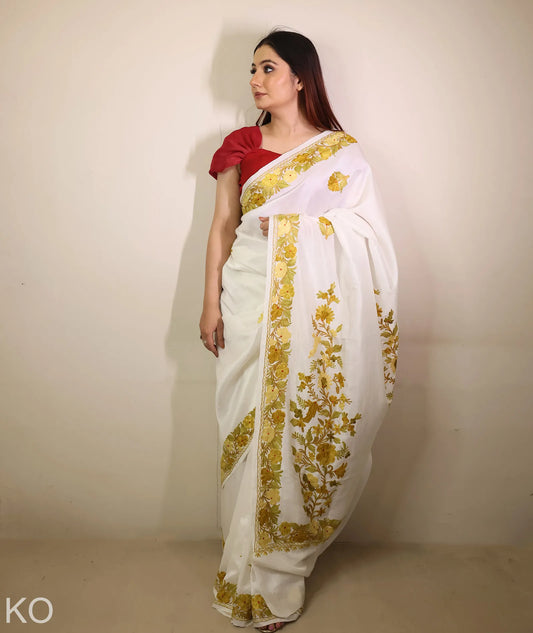 -38% OFF
-38% OFFWhite Embroidered Crape Saree
Regular price Rs. 4,999Regular priceUnit price / perRs. 8,095Sale price Rs. 4,999-38% OFF -

 -38% OFF
-38% OFFPeach Embroidered Crape Saree
Regular price Rs. 4,999Regular priceUnit price / perRs. 8,095Sale price Rs. 4,999-38% OFF -
Light Olive Green Shade Embroidered Georgette Saree
Regular price Rs. 4,999Regular priceUnit price / perRs. 7,429Sale price Rs. 4,999-32% OFF -
Turquoise Embroidered Georgette Saree
Regular price Rs. 4,999Regular priceUnit price / perRs. 7,429Sale price Rs. 4,999-32% OFF -
Soft Green Embroidered Maroon Georgette Saree
Regular price Rs. 4,999Regular priceUnit price / perRs. 7,429Sale price Rs. 4,999-32% OFF -
Black Forest Green Chinar Aari Embroidered Georgette Saree
Regular price Rs. 4,999Regular priceUnit price / perRs. 7,429Sale price Rs. 4,999-32% OFF -
Red Chinar Aari Embroidered Yellow Base Crepe Saree
Regular price Rs. 4,999Regular priceUnit price / perRs. 7,429Sale price Rs. 4,999Sold out


